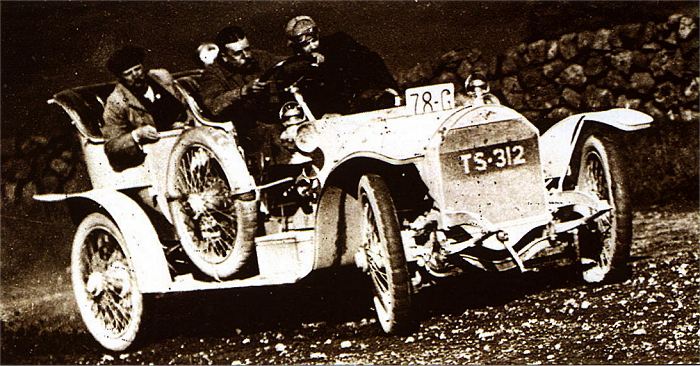In the dawn of automotive history, when engineers were still discovering the boundaries of internal combustion engine design, Ariel unveiled a machine that would challenge every convention. The 50/60 HP, introduced in 1907, housed an unprecedented 15.9-liter engine — the largest ever fitted to a British automobile at the time. This engineering marvel emerged from Birmingham’s industrial heart, representing the pinnacle of Edwardian-era automotive achievement.
The limited production run of 1907-1908 positioned the Ariel 50/60 HP not just as a means of transportation, but as a bold statement of British engineering prowess. While competitors focused on modest four-cylinder designs, Ariel’s six-cylinder powerhouse demonstrated an ambitious vision that would influence automotive development for decades to come.
The Heart of the Beast: Engineering Excellence
The 50/60 HP’s massive 15.9-liter engine wasn’t just about raw numbers — it represented a quantum leap in engineering capability. Each cylinder displaced more than many complete engines of the era, yet worked in perfect harmony with its five companions. The engine’s design reflected Ariel’s commitment to pushing the boundaries of what was possible in early 20th-century manufacturing.
Historical Reference!
When the Ariel 50/60 HP debuted, the average automobile engine displaced merely 2-3 liters. The decision to build an engine nearly eight times larger required entirely new manufacturing processes and metallurgical innovations.
«The Ariel 50/60 represents the absolute peak of Edwardian engineering ambition», notes James Worthington-Smith, curator at the British Motor Heritage Museum. «The sheer audacity of building such a massive engine in 1907 speaks volumes about the confidence and capability of British industry at its height».
Engineers today still marvel at the precision required to cast and machine engine blocks of such size with the primitive tools available in 1907. The crankshaft alone required specialized manufacturing techniques that wouldn’t become commonplace for another two decades.
Birmingham’s Finest: The Manufacturing Story
Ariel’s Birmingham facilities represented the cutting edge of early 20th-century manufacturing. The company’s decision to produce such an ambitious automobile speaks to the city’s industrial might during the Edwardian era.
Fact!
Ariel's Birmingham factory employed over 1,000 skilled craftsmen, many of whom had backgrounds in precision watchmaking — skills that proved essential in manufacturing the complex engine components.
The production process combined traditional craftsmanship with emerging mass production techniques. Each engine required over 200 hours of machining and assembly work, with tolerances that would remain impressive even by today’s standards.
«To manufacture something of this complexity in 1907 required not just engineering skill, but a complete rethinking of production methods», explains Dr. Sarah Henderson, Industrial Archaeology specialist. «Ariel essentially had to invent new manufacturing processes just to make this engine possible».
This commitment to manufacturing excellence came at a cost — by late 1907, the automobile division had exhausted its resources, leading to the sale of its Birmingham assets.
Performance and Racing Heritage
The 50/60 HP’s debut coincided with the opening of the Brooklands racing circuit, Britain’s first purpose-built motor racing venue. The timing couldn’t have been more significant:
- six-cylinder smoothness providing unprecedented reliability;
- massive displacement delivering consistent power output;
- robust construction allowing sustained high-speed operation;
- advanced cooling system enabling extended racing sessions;
- sophisticated lubrication ensuring engine longevity.
The car’s performance capabilities exceeded the limitations of most roads of the era, making Brooklands the perfect showcase for its potential.
Exclusivity and Legacy
The Ariel 50/60 HP represented the pinnacle of luxury motoring in its brief production run. Each vehicle was essentially bespoke, tailored to its wealthy owner’s specifications.
«These weren’t just automobiles — they were statements of industrial might and personal achievement», notes vintage car collector Michael Rathborne. «Owning an Ariel 50/60 HP in 1907 was akin to owning a Bugatti Chiron today».
The legacy of the 50/60 HP extends far beyond its brief production run. Its influence can be seen in the development of large-displacement engines throughout the 20th century, particularly in luxury and racing applications.
A Vision of Tomorrow
The Ariel 50/60 HP wasn’t just an automobile — it was a glimpse into the future of automotive engineering. Its revolutionary design and unprecedented power output set standards that would influence automobile development for decades to come.
Today, this remarkable machine stands as a testament to the ambition and capability of early British automotive engineers. While few examples survive, each represents a pivotal moment in automotive history when the impossible became possible through sheer engineering determination.
Pros and Cons
| Advantages | Disadvantages |
|---|---|
| Largest engine capacity in Britain (15.9L) – unprecedented power output | Limited production run affecting parts availability |
| Advanced six-cylinder design providing smooth operation | High fuel consumption even by period standards |
| Premium build quality with excellent craftsmanship | Extremely high manufacturing costs leading to company financial strain |
| Innovative engineering solutions influencing future designs | Complex maintenance requirements |
| Prestigious status symbol of the Edwardian era | Weight impacting overall performance |
| Racing potential demonstrated at Brooklands | Limited documentation surviving to modern day |
| Handcrafted excellence in every component | Significant operating costs |
The Ariel 50/60 HP represents a unique moment in automotive history when engineering ambition exceeded practical considerations, resulting in a machine that pushed the boundaries of what was possible. While its commercial success may have been limited, its impact on automotive engineering and its status as a benchmark for excellence ensure its place in the pantheon of automotive greatness.

